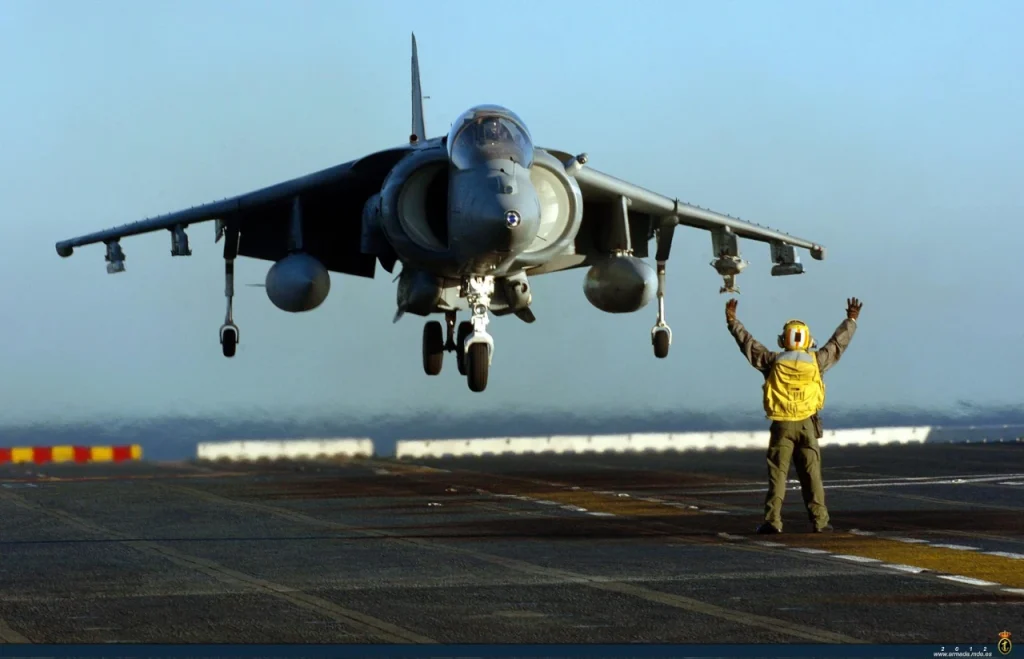With the announcement of the Spanish Defense Budgets for 2023, many in Spain have taken it for granted that the F-35 would be acquired. However, this issue is not as straightforward and is now a hotly debated topic as it puts European defence projects like the Future Combat Air System (FCAS) into the doldrums.
Without a substantial course correction, the Spanish Government and Ministry of Defense, except for the Royal Navy, have not formally endorsed the Lockheed Martin F-35. However, speculation has heightened due to two elements contained in the Ministry of Defense’s Annex of genuine investments and multi-year plans.
Two items are scheduled to begin receiving funding in 2023: “replacement aircraft for the C.15M” (EF-18 Hornet) allocated with €4.5 billion, and “replacement aircraft for the AV-8B (Spanish Navy Harriers) and C.15M – 2nd Phase” with € 6.25 billion.
The inclusion of the McDonnell Douglas AV-8B Harrier II of the Spanish Navy Aircraft Flotilla in the second item, which can only be replaced by the F-35B, led to the immediate interpretation that they were intended, at least in part, for the procurement of F-35 aircraft.
It may seem that everything is riding on the American aircraft for the Spanish Navy and the Air Force. It would entail accepting the suggestions of the Spanish air force at face value, in the sense that it would be more convenient to operate with a second model rather than basing the whole force on the European Eurofighter and that this second model is of the fifth generation. This final point is crucial since it implies saying “F-35” without stating it.
If the first assumption is accepted and the F-35 is bought, this programme would get €10.75 billion for about 60 and 65 well-equipped and armed aircraft. Twelve or fourteen (F-35B version) of these aircraft would be sent to the Navy Aircraft Flotilla LHD Juan Carlos I, while the remaining would equip the Torrejón and Zaragoza Wings, replacing the F-18. Consequently, Spain would become one of the most important European partners in the F-35 initiative, which would have undeniable benefits. Still, that doesn’t seem like a very plausible possibility. In 2029 the Harrier ceases to be operational as a fixed-wing element embarked on the LHD Juan Carlos I.”

If the second hypothesis is adopted, it would suggest that two models would replace the F-18. One would be the Eurofighter in its most recent configuration, comparable to the most advanced ones. This may correlate to the first phase allocating €4.5billon, which would allow purchasing of 30 to 40 new aircraft.
Spain has already initiated the Halcón programme for the Air Force to replace the F-18 of the Canary Islands with a budget of 2.043 billion euros to acquire 20 Eurofighter Typhoons in the most advanced version available, the so-called Quadriga, which would be equivalent to a Tranche 4 order similar to the one placed by Germany.
The above information suggests that the F-35 would replace the F-18 and Harrier during their second replacement phase. It is natural to assume that since the two aircraft types have been named separately. If the Harrier replacement is a combined purchase in the second phase of the F-18 replacement, it may not be the F-35. With € 6.25 Billion, Spain could acquire 35-38 aircraft, 12-14 for the Navy and the remainder to equip two Air Force squadrons.
What are the chances for an F-35 purchase by the Spanish Government?
In the first place, the Spanish Government has consistently denied any interest in American aircraft, betting instead on continuity with European political and industrial partners, a commitment that materialised with the purchase of new Eurofighters and Spain’s entry into the FCAS, with Indra serving as the national liaison.
Second, every military equipment procurement programme requires the maker to present an industrial plan, which Lockheed Martin has not done to date despite the absence of a formal acquisition programme.
But, buying the F-35 will enable the Spanish pilots to get acquainted with the fifth generation aircraft and transition to the sixth generation FCAS project in the future. It will also help interoperability with NATO partners except for France.
Spain may also choose to buy just 12 F-35 for the harrier replacement and lose all the industrial benefits of buying 65 F-35s. Also, the F-35B comes with expensive maintenance options. F-35Bs cost around 100 million euros per aircraft, excluding maintenance and operation. Some of the Harrier’s tasks can be done by helicopters, especially since Spanish primary interests and sources of concern are so close to its coasts and peninsula, which hardly justifies the high cost of acquiring a carrier-based fighter.
Bets on Eurofighter Typhoon
The defence industrial base, particularly the aerospace industry, of Spain is heavily oriented toward producing the Eurofighter Typhoon, which would facilitate the production of new planes beyond the Halcón/Quadriga without the need to calculate returns or search for manufacturing facilities from scratch.
Commitment to the F-35 means the end of industrial benefits to be derived by the FCAS programme in the future. In addition to future fighter aircraft and UAVs, these technologies include new sensors, simulation, propulsion, and low observability. Given the complexity of many technologies, they will be developed via multinational initiatives sponsored by European instruments such as PESCO or the European Defense Fund (EDF).
